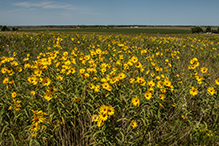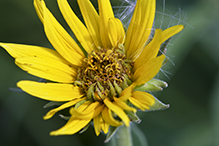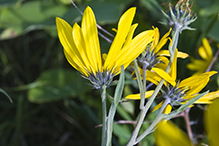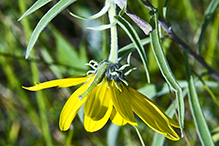Maximilian’s sunflower
(Helianthus maximiliani)
Conservation • Wetland • Description • Habitat • Ecology • Use • Distribution • Taxonomy
Conservation Status |
|||
| IUCN Red List | not listed |
||
| NatureServe | N5 - Secure SNR - Unranked |
||
| Minnesota | not listed |
||
Wetland Indicator Status |
|
||
| Great Plains | FACU - Facultative upland |
||
| Midwest | UPL - Obligate upland |
||
| Northcentral & Northeast | UPL - Obligate upland |
||
Description |
Maximilian’s sunflower is an erect perennial forb that rises often on several stems from a short-creeping rhizome and fleshy roots. It often forms dense colonies. It can be from 24″ to 120″ tall, though in Minnesota it is it is usually no more than 72″ in height. It sometimes forms colonies. The stems are erect, stout, round, rough to the touch, and light green or sometimes reddish. They are not glaucous. They are moderately to densely covered with white, short, stiff, ascending hairs, especially near the top. They are mostly unbranched below the inflorescence. There are usually more than 30 leaf nodes on the stem. There are no basal leaves. Lower stem leaves are opposite and short-stalked, middle and upper leaves are alternate and short-stalked or stalkless. All leaves are firm, lance-shaped or narrowly lance-shaped, 1½″ to 11½″ long and 3 ⁄16″ to 2 3 ⁄16″ wide, 7 to 20 times as long as wide. They taper at the base to a winged leaf stalk that is up to ¾″ long, and taper to a sharp point at the tip. The leaf blade is folded horizontally along the midrib, rises at the point of attachment, then arches downward longitudinally. The upper and lower surfaces are grayish-green and rough to the touch. They are covered usually densely, sometimes moderately, with minute, white, appressed hairs. The margins are usually untoothed, sometimes with minute, widely-spaced teeth. The leaves have a prominent midvein and no prominent lateral veins. The inflorescence is occasionally a solitary head at the end of the stem. More often, it is an unbranched clusters of 3 to 15 flower heads at the end of the stem along with solitary heads or small clusters rising from the upper leaf axils. The flower heads are 1¾″ to 4″ wide on stalks that are ⅜″ to 4⅓″ long. There is a whorl of 30 to 40 bracts (involucre) in 2 or 3 overlapping series at the base of the flower head. The involucre is hemispheric in shape and ⅝″ to 1⅛″ in diameter. The bracts are loosely ascending, and are spreading or bent backward at the tip. They are narrowly lance-shaped to nearly linear, and taper to a sharply-pointed tip. They are moderately to densely covered on the back with short, white hairs, and have a dense fringe of short hairs along the margin, at least near the base. There are 10 to 25 yellow ray florets and 75 or more yellow disk florets. The fruit is an achene. |
Height |
24″ to 79″ |
Flower Color |
Yellow ray florets, yellow disk florets |
Similar Species |
The grayish-green foliage and narrow, single veined, arched, folded leaves distinguish this species from all other sunflowers in Minnesota. |
Habitat |
Moderately moist to dry. Prairies, railroads, roadsides, disturbed areas. Full sun. Sandy soil. |
Ecology |
Flowering |
June to October |
Pests and Diseases |
Sunflower bullet gall midge (Pilodiplosis helianthibulla) makes ¼″ in diameter, almost globe-shaped galls on the leaves of plants in the genus Helianthus. |
Use |
|
Distribution |
||
|
Sources Biodiversity occurrence data published by: Minnesota Biodiversity Atlas (accessed through the Minnesota Biodiversity Atlas Portal, bellatlas.umn.edu, 9/5/2025). |
|
| 9/5/2025 | ||
Nativity |
||
| Native | ||
Occurrence |
||
Common |
||
Taxonomy |
|
Kingdom |
|
Division |
Tracheophyta (Vascular Plants) |
Subdivision |
Spermatophytina (Seed Plants) |
Class |
|
Order |
Asterales (Sunflowers, Bellflowers, Fanflowers, and Allies) |
Family |
Asteraceae (Sunflowers, Daisies, Asters, and Allies) |
Subfamily |
Asteroideae |
Tribe |
Heliantheae (Sunflowers and Allies) |
Subtribe |
Helianthinae |
Genus |
Helianthus (sunflowers) |
Subordinate Taxa |
|
|
|
Synonyms |
|
Helianthus dalyi Helianthus maximiliani var. asperrimus Helianthus maximiliani var. dalyi Helianthus maximiliani var. iubaris Helianthus maximiliani var. maximiliani Helianthus maximiliani var. paniculata |
|
Common Names |
|
Maximilian sunflower Maximillian sunflower Maximilian’s sunflower |
|
Glossary
Achene
A dry, one-chambered, single-seeded seed capsule, formed from a single carpel, with the seed attached to the membranous outer layer (wall) only by the seed stalk; the wall, formed entirely from the wall of the superior ovary, does not split open at maturity, but relies on decay or predation to release the contents.
Bract
Modified leaf at the base of a flower stalk, flower cluster, or inflorescence.
Glaucous
Pale green or bluish gray due to a whitish, powdery or waxy film, as on a plum or a grape.
Involucre
A whorl of bracts beneath or surrounding a flower, flower head, or flower cluster.
Node
The small swelling of the stem from which one or more leaves, branches, or buds originate.
Rhizome
A horizontal, usually underground stem. It serves as a reproductive structure, producing roots below and shoots above at the nodes.
Winged leaf stalk
A leaf stalk with a leaf-like or membrane-like extension along both sides.
Visitor Photos
Share your photo of this plant.
This button not working for you?
Simply email us at info@MinnesotaSeasons.com.
Attach one or more photos and, if you like, a caption.
Bill Reynolds |
||
Long-horned bee |
||
 |
 |
|
Two Long-horned bees on a Maximilian Sunflower |
||
|
||
|
||
|
… just a single bee on the Maximilian |
|
MinnesotaSeasons.com Photos
 |
 |
|
Colony |
Plant |
|
 |
 |
|
Plant |
Plant |
|
 |
 |
|
Flower head |
||
|
||
|
||
Plant |
|
|
 |
 |
|
Flower head |
Disk |
|
 |
 |
|
Involucre |
Involucre |
|
 |
 |
|
Leaves |
Leaves |
|
 |

|
|
Leaves |
||
|
||
|
||
|
Late spring |

Slideshows
Helianthus maximiliani
Matt Lavin

Visitor Videos
Share your video of this plant.
This button not working for you?
Simply email us at info@MinnesotaSeasons.com.
Attach a video, a YouTube link, or a cloud storage link.
Other Videos
Minnesota Native Plant - Maximilian Sunflower (Helianthus Maximiliani)
MNNativePlants

Visitor Sightings
Report a sighting of this plant.
This button not working for you?
Simply email us at info@MinnesotaSeasons.com.
Be sure to include a location.
Minnesota Seasons Sightings
Carpenter St. Croix Valley Nature Center
Carver Highlands WMA, South Unit
Felton Prairie SNA, Bicentennial Unit
Felton Prairie SNA, Shrike Unit
Margherita Preserve-Audubon Prairie
Mound Spring Prairie SNA, North Unit
Northern Tallgrass Prairie NWR, Hoffman Unit
Northern Tallgrass Prairie NWR, Pavia Unit
Northern Tallgrass Prairie NWR, Spieker Unit
Northern Tallgrass Prairie NWR, Touch the Sky Prairie Unit
Pankratz Memorial Prairie, North Unit
Pembina Trail Preserve SNA, Crookston Prairie Unit
Pembina Trail Preserve SNA, Pembina Trail Unit
Richard M. & Mathilde Rice Elliott SNA
Robert Ney Memorial Park Reserve
Two Rivers Aspen Prairie Parkland SNA
Verlyn Marth Memorial Prairie SNA


